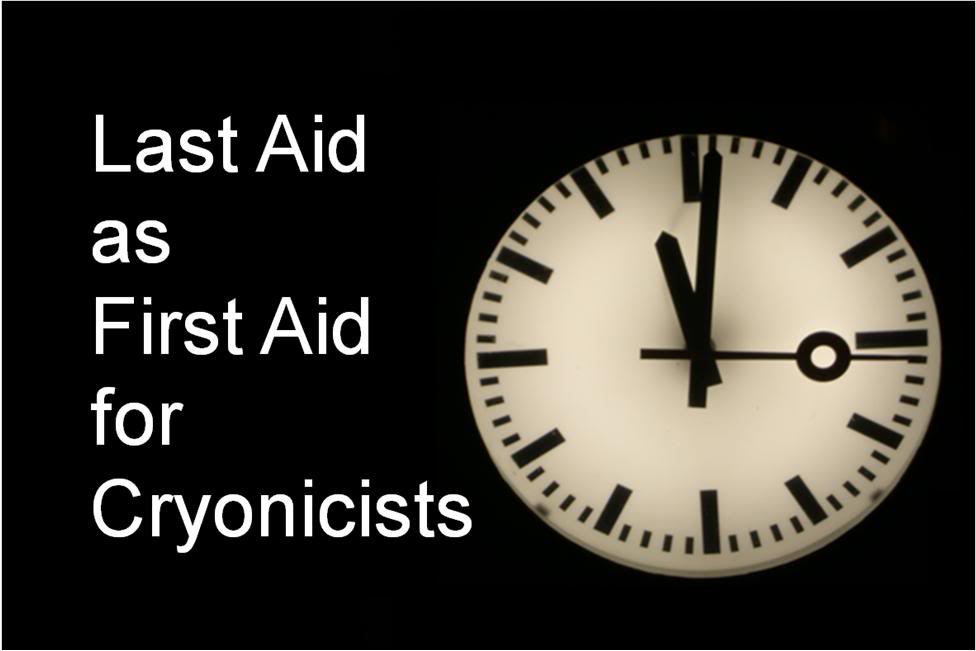 By Mike Darwin
By Mike Darwin
A Bit of Background
This piece, and the previous one in this series, was written over four years ago. The articles which now constitute these first “Last Aid”articles here on Chronosphere were submitted to both the Cryonics Institute and to the Alcor Life Extension Foundation. Both organizations declined to publish them. The reasons given were interesting. One was that the use of “flash” or “jump” drives to store cryonics emergency information and procedures on the persons of members was impractical. I was told that “No one would know what to do with such a thing dangling around a “dead”or dying cryonicist’s neck – and what’s more, a phone number on a metal ID tag or bracelet puts the people caring for the member in touch with the cryonics organization anyway, so why bother with a jump drive”
The second reason given was that cryonics “first aid” was dangerous, and shouldn’t be practiced. Doing anything to a member/patient could get him autopsied, get the good Samaritan thrown in jail, and in any event, only cryonics organization personnel would, properly, know what to do. A few days ago I was waiting for a prescription to be filled at the local Walgreen’s, and as I walked around waiting, I saw was one of these on the shelf:
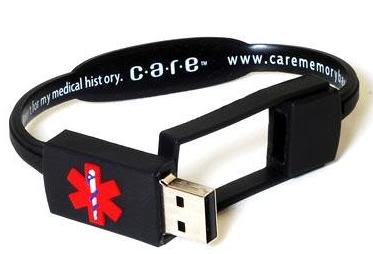
Figure 1: Flash drive emergency medical information bracelet which could, in addition to holding a cryonicist’s medical history, can also provide detail and well illustrated instructions for paramedical, medical and mortuary personnel.
There it was, the commercial implementation of the very idea I’d been trying to sell cryonics organizations on years before. When I got home, I logged on to the Internet and sat slack-jawed at the range of USB flash drive emergency medical information products I saw there. So please, keep this in mind when you come to the section about putting cryo-critical information on flash drives. I have updated that section, but if the tone seems a little gee-whiz, well it’s because it was written about 40 years ago in computing technology time.
 Its now a mainstream medical practice for emergency medical and contact information to be put on wearable flash drives, and it’s one that, cryonics aside, may just save your life. You can now store your baseline electrocardiogram, your complete list of medications and supplements, and your complete and search-able medical records and history on your wrist, or around your neck. The latter is becoming increasingly easy for individual patients to obtain as both hospitals and physicians’ offices go paperless. And that can be a lifesaver, because many critical treatment decisions are made in a vacuum due to the inability of the patient to communicate the necessary information, his lack of understanding of what is important to communicate, and increasingly, because of the Privacy Rule in the Health Insurance Portability and Accountability Act of 1996 (HIPAA) legislation, which provides severe penalties for “unauthorized” disclosure of personal medical information. This has resulted in hospitals and physicians’ offices refusing to disclose potentially life saving information in an emergency. So please, consider jump drive storage of you medical history and your insurance information and ICE contacts, even if you don’t use it for cryonics.
Its now a mainstream medical practice for emergency medical and contact information to be put on wearable flash drives, and it’s one that, cryonics aside, may just save your life. You can now store your baseline electrocardiogram, your complete list of medications and supplements, and your complete and search-able medical records and history on your wrist, or around your neck. The latter is becoming increasingly easy for individual patients to obtain as both hospitals and physicians’ offices go paperless. And that can be a lifesaver, because many critical treatment decisions are made in a vacuum due to the inability of the patient to communicate the necessary information, his lack of understanding of what is important to communicate, and increasingly, because of the Privacy Rule in the Health Insurance Portability and Accountability Act of 1996 (HIPAA) legislation, which provides severe penalties for “unauthorized” disclosure of personal medical information. This has resulted in hospitals and physicians’ offices refusing to disclose potentially life saving information in an emergency. So please, consider jump drive storage of you medical history and your insurance information and ICE contacts, even if you don’t use it for cryonics.
How Bad is Bad Enough?
To fix a problem you first have to understand that you have one. While all cryonicists understand the idea that time after cardiac arrest without cooling or other stabilization is not good, few can even describe this injury by its proper name; ischemic injury. Fewer still can provide even the barest details about its mechanics and time course, and only a handful of cryonicists would even be able to voice an opinion about at what point in this process they think such damage might become irreversible (short of complete decomposition). Almost none could give reasons as to what constitutes the basis for their opinion. This state of affairs is both unacceptable and dangerous. It is unacceptable because it has been 47 years since cryonics began, and during that time an enormous amount has been learned about the biological basis of personality and memory, and about ischemic injury and ways to reduce, if not eliminate it. Failing to act in the face of such knowledge is inexcusable.
 It is dangerous because, absent a solid understanding of the nature and time course of ischemic injury (which at some point becomes more properly described as postmortem decomposition), it is impossible to know what to do, when to do it, or to feel any urgency about taking action. Thus, injury that could have been minimized, or completely avoided, is more likely to occur; and in the worst case, the patient will pass from cardiac arrest into true information-theoretic death. In other words, if you have no idea when bad becomes irreversibly and lethally bad, you have no point of reference, no sense of urgency, and little ability to avoid lethal situations. Under these circumstances cryonics becomes more akin to a ritual, wherein any application of cold to a “corpse” at any point in the decomposition process is deemed not only necessary, but sufficient to assure a chance at recovery.
It is dangerous because, absent a solid understanding of the nature and time course of ischemic injury (which at some point becomes more properly described as postmortem decomposition), it is impossible to know what to do, when to do it, or to feel any urgency about taking action. Thus, injury that could have been minimized, or completely avoided, is more likely to occur; and in the worst case, the patient will pass from cardiac arrest into true information-theoretic death. In other words, if you have no idea when bad becomes irreversibly and lethally bad, you have no point of reference, no sense of urgency, and little ability to avoid lethal situations. Under these circumstances cryonics becomes more akin to a ritual, wherein any application of cold to a “corpse” at any point in the decomposition process is deemed not only necessary, but sufficient to assure a chance at recovery.
This situation can only be remedied by detailed information about the damage that results from both warm and cold ischemia, and a clear explication of its likely practical implications for revival, and recovery of personal identity. In one sense it is absolutely the case that, with a change in US law, almost all cryopatients are going to be revived. If human cloning were to be made allowable tomorrow, every cryopatient with an intact genome could be revived, but the question is, as whom? Few of us would be satisfied to see a tabula rosa genetic duplicate be all that is recovered, and many, if not most of us would rightly question if the recovery or creation of such an individual really constituted our personal survival. For most of us, to survive is to remember, and to be the person that decades of unique experiences and unique brain structure have built up and created. In order for us to survive in that form, the fine structure of our brains that encodes those experiences and our unique responses to them, must survive in a sufficiently robust condition to be retrieved and restored to consciousness.
For the first time since the inception of cryonics, it is possible to state with reasonable confidence that essentially complete ultrastructural preservation of the brain is now technologically achievable. This revolutionary change is a result of recent advances in brain cryopreservation, where it has been demonstrated that the ultrastructure of mammalian brains vitrified under controlled conditions (in the absence of ischemic injury) preserves both brain ultrastructure 1-3 and the biochemistry that underlie long-term potentiation (LTP); the mechanism currently believed to be the first (and perhaps the most delicate) step in encoding memories. 5,6
Unfortunately, these results will be meaningless for cryopatients who have suffered loss of identity-critical information before cryopreservation, or who suffer such losses as a result of ischemic injury which interferes with adequate cryoprotection and vitrification or freezing. The frustrating and unbelievable reality is that never in the history of cryonics has the disconnect between what is technically possible, and the reality of what is actually clinically available to human cryopatients, been greater. There can be no doubt that a huge part of the reason for this, is a lack of understanding of how destructive ischemic injury is, and how routinely and often unnecessarily it is happening to cryopatients. In fact, long ischemic periods, and other substandard care are now the rule for cryopatients, and it is the exceptional patient who receives a level of care even approaching that which is now technically possible.
Cryonics 101: Understanding Ischemia
Take a good, long, hard look at Figure 2 below. It is a snapshot of the ultrastructural changes that go on after cardiac arrest over a 24-hour period in the absence of profound cooling (i.e., to 2 to 4 degrees C). Even the untutored eye can see the deterioration of brain cell structure as ischemic time increases.
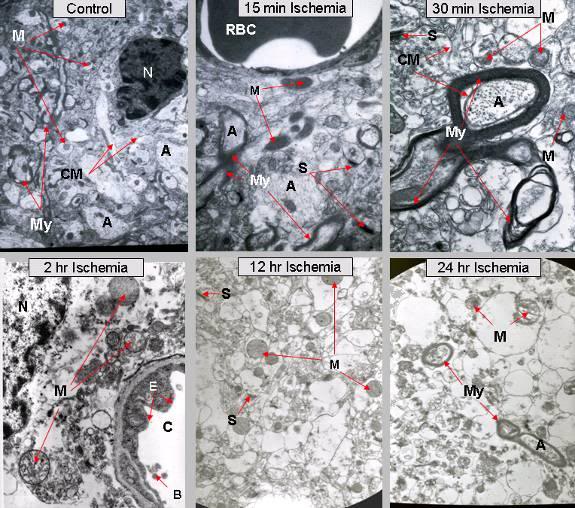 Figure 2: In 1984, Jerry Leaf and I undertook a study to try and determine the time course of brain, and other vital organ ultrastructural changes, as a function of ischemic time and temperature. Dogs were anesthetized, placed into cardiac arrest, and then allowed to cool passively to room temperature (RT) where they were held for varying periods of time, up to 24 hours postmortem. Representative results are shown in the six micrographs above. It is interesting to note that by 24 hours of RT ischemia, red blood cells are very rarely seen with either light or electron microscopy, presumable because they have undergone hemolysis. Red cells are rugged compared to brain cells. If they are disappearing what is the fate of the neurons and glial cells?
Figure 2: In 1984, Jerry Leaf and I undertook a study to try and determine the time course of brain, and other vital organ ultrastructural changes, as a function of ischemic time and temperature. Dogs were anesthetized, placed into cardiac arrest, and then allowed to cool passively to room temperature (RT) where they were held for varying periods of time, up to 24 hours postmortem. Representative results are shown in the six micrographs above. It is interesting to note that by 24 hours of RT ischemia, red blood cells are very rarely seen with either light or electron microscopy, presumable because they have undergone hemolysis. Red cells are rugged compared to brain cells. If they are disappearing what is the fate of the neurons and glial cells?
After 12-hours of warm (room temperature) ischemia in the dog, there is virtually a complete loss of cell (plasma) membrane structure and dramatic degradation of the ground substance; the molecular weave that makes up the cytoplasm of the cell. By 24-hours there are no neuronal or other plasma membranes present and no clearly identifiable synapses. Another way of stating this is to say that sometime between 2 and 12 hours of warm ischemia it is very likely that true (information theoretic) death has occurred. It is also important to understand that these micrographs were made without the additional insults of reperfusion, cryoprotection and freezing or vitrification – or worse still, freezing in the absence of cryoprotection or vitrification because ischemia has rendered the patient impossible to perfuse.
Since the time we did our work on ultrastructural changes in ischemia, the topic has become a subject of interest in mainstream biomedicine. The grim results in our study have been both tempered and confirmed by the work others. In humans who have suffered sudden cardiac death the rate of autolysis appears to be close to that which was observed in our dog work. However, several studies in rats show considerably more conservation of ultrastructure, even at 24 hours postmortem at room temperature.7-10 However, regardless of the rate of autolysis, effective perfusion becomes impossible within a few hours of the onset of cardiac arrest, at best.
While some (capital N Nanotechnology) apologists will no doubt argue that the ultrastructural changes revealed by TEM are really a failure of our current imaging techniques (which rely on chemical fixation and heavy metal staining of tissues to be examined using TEM), few would argue that such changes are not a very bad sign and that they do not constitute an eminently reasonable standard to use in objectifying and broadly quantifying injury from ischemia. Perhaps the best response to those who would minimize the gravity of these changes is simply to ask them, “Which group do you want to be in, one of the experimental groups, or the control?” Clearly, any rational person with a choice would choose to be as close to the control (no ischemia) group as possible.
The great irony here, is that this is the one technical area in cryonics where we do have an opportunity to choose how much damage we will likely experience, based on our degree of motivation and preparedness. Aside from supporting basic research, there is little we can do to alter the limitations of even the best of today’s vitrification techniques. Research itself is an uncertain business, whose progress is often independent of time and money, and often comes only as a result of overall technological progress. Avoiding ischemic injury is different, we know many ways to do this and for a significant number of cryopatients it is both technically and economically possible, with modest preparation.
Abandon All Hope?
This does not mean that it is irrational or unreasonable to proceed with cryopreservation even if brain ultrastructure looks as bad as it does at 24 hours postmortem in Figure 2, above, if there is absolutely no other alternative. It is possible that a lot of the apparently missing structure might have been washed away during the fixation and preparation process for examination. However, no prudent person would assert that because things might be better than they seem in such a bleak situation, it is acceptable to let such damage occur, when it can be avoided.
We have the same obligation in cryonics that is incumbent upon the rest of medicine, and that is to first do no harm (primum non nocerum). This injunction does not mean that a surgeon cannot wound a patient or that an oncologist cannot administer cytotoxic drugs. What it does mean is that these interventions can only be used when there is a reasonable expectation that they will do more good than harm and further, that we are proscribed from acting in ways that we know, or can reasonably be expected to know, cause damage. There is certainly no good to be gained from allowing the kind of damage to proceed that is seen in the micrographs above and we have the knowledge, the technology, and the resources to avoid it. To fail to use them to prevent this kind of injury is utterly inexcusable.
Knowledge Isn’t Power Unless You Use It
Aside from the lack of vision to do it, a major obstacle to making cryonics first aid a reality has historically been the limitations imposed by the cumbersome technology required to access and transport information. It has long been possible to prepare an encyclopedia of instructions on how to handle cryonics emergencies, but it has not been practical to have that information instantly accessible around the clock, almost anywhere in the world, 365-days-a-year. Nor was it possible, let alone practical, for cryonicists to carry several bound volumes of emergency instructions and detailed procedures with them everywhere they went. And, even if this were practical, say by using microfiche, it would be almost impossible to access the information effectively. This is no longer the case.
The Future Was Yesterday
The average cryonicist is over 30-years-old, and that means that he or she should realize that the developments in computing technology have been fantastically better, and occurred fantastically sooner, than most of us dreamed possible. We can now go almost anywhere in the world and still be connected to vast reservoirs of detailed information that are available to us in amazingly user-friendly ways. If we want to know how to fix a leaky faucet, or how to administer first aid for a wide range of injuries, we can go to Google and type in the words “leaky faucet” or “first aid” and voila, there are a wide range of websites providing detailed instructions and even step-by-step online videos on how to fix faucets or administer first aid for everything from a serious burn to a broken leg. If we need a good recipe for pound cake, want the concept of specific heat explained clearly, or need the value of pi to 20 decimal places, it is all available to us literally at our fingertips and in seconds. That is surely pure science fiction wonder made real to anyone over thirty.
Pictured in Figure 3 is a generic 2 gigabyte USB flash drive which retails for $10.00 US. It can easily be worn as an addition to the standard cryonics emergency stainless steel neck tag. But it suffers from the deficiency that it is not waterproof and it has not been engineered to withstand impacts or harsh conditions
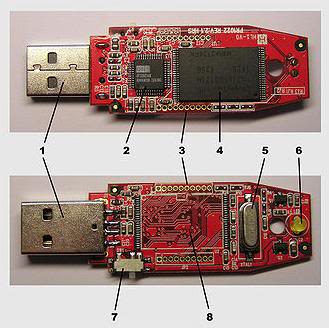
Figure 3: Typical flash drive.
1 USB connector
2 USB mass storage controller device
3 Test points
4 Flash memory chip
5 Crystal oscillator
6 LED
7 Write-protect switch (Optional)
8 Space for second flash memory chip
Figure 3: USB Flash drive memory storage device. Storage capacities are now (2011) as large as 256 GB with steady improvements in size and price per capacity expected. Some flash drives allow 1 million write or erase cycles and have a 10-year data retention cycle.
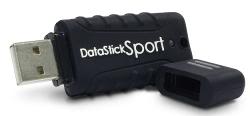 Figure 4: The Centon 16 gb flash drive is housed in a shock resistant silicone rubber case and is waterproof when closed with the sealing silicone rubber cap.
Figure 4: The Centon 16 gb flash drive is housed in a shock resistant silicone rubber case and is waterproof when closed with the sealing silicone rubber cap.
In the last few years, rugged, military specification flash drives have become available that offer varying degrees of resistance to environmental stress. At the “low”end is the Centon 16 gb DataStick Sport (Figure 4) which has a durable silicon casing with a leak-proof cap design making the drive waterproof and shock resistant which retails for $26.00.At the high end, is the the LaCie XtremKey, with a 64GB capacity and an “impenetrable” shell made of 2mm thick Zamac, a metal alloy composed of zinc, aluminum, magnesium and copper that has extreme crush resistance. The drive seals with a screw cap closure and a rubber O-ring, which makes it water tight to 100 meters. In addition, it’s resistant to 5-meter drops, and is rated to perform in temperatures from +200°C / -50°C (Figure 5).
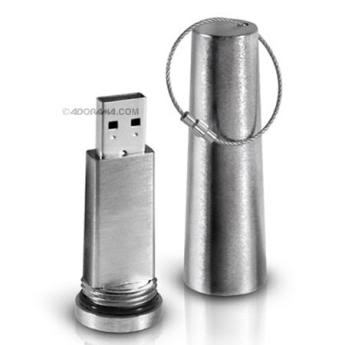 Figure 5: LaCie XtremKey, with a 64GB capacity with an “impenetrable” shell made of 2mm thick Zamac metal alloy and a working temperature range of +200°C / -50°C.
Figure 5: LaCie XtremKey, with a 64GB capacity with an “impenetrable” shell made of 2mm thick Zamac metal alloy and a working temperature range of +200°C / -50°C.
Thus, it has been at least 9-years since anyone in cryonics had to be in the position of trying to explain to a mortician, a patient’s family member, or to a willing volunteer what do in an emergency without being able to walk that person through the necessary procedures visually and verbally every step of the way. What’s more, in many instances those instructions could be available for repeated viewing when and where needed, including as the procedures are being carried out. Even something as simple as packing a patient in ice for air transport is in reality not so simple, and it is easy for the attending mortician or volunteers to make a mistake, such as using too little ice, or conversely, heaping ice on the chest and abdomen which puts the patient’s blood under hydrostatic pressure causing it to become a thick sludge, as much of the water filters out of it, and into the tissues.
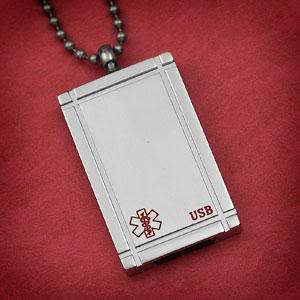
Figure 6: Neck tag style stainless steel emergency medical information USB jump. drive
There are also now a wide range of emergency medical information flash drives – devices with software designed to capture medical information, organize it, and make it accessible to emergency medical service providers (Figures 6 & 7).
So, why aren’t we using these technologies in cryonics? Why are there no user-friendly, step-by-step emergency cryonics instructions online, or on a jump drive hanging around your neck? What do the 9 paid, full time employees of cryonics organizations (http://www.alcor.org/AboutAlcor/meetalcorstaff.html) do all day, every day, year in and year out? It seems that the future was yesterday, and we cryonicists let pass us by.
Failure to appreciate and embrace this technology has been costly – probably more costly than most cryonicists appreciate. It has prevented cryonicists remote from immediate or very rapid response in the event of an emergency from preparing to help themselves and their families in the most basic ways, such as effectively cooling a patient until help arrives, being able to provide a local paramedic, registry RN, or other person with intravenous access skills with clear, visual, step-by-step instructions on how to give medications that can vastly reduce ischemic injury and maintain the patency of the circulatory system for cryoprotective perfusion – medications and the simple, inexpensive supplies to administer them that all cryonicists at high risk of unanticipated arrest should have on-hand and at-the-ready. In many areas of the world (including the US) paramedical personnel can be found locally on short notice who are capable of administering stabilizing intravenous medications if they have the medications, the administration supplies, and above all the visual, verbal and written instructions available via computer to show them how to do use them. These resources are not being used in large measure because the instructional tools and necessary supplies are not available in emergencies. Indeed, the deeper problem seems to be that cryonics organizations fail to understand that most emergencies are readily foreseeable.

Figure 7: Emergency medical information USB jump drive with accompanying engrave-able neck tag.
How many cryonics organizations have members over age 70, in poor health, at high risk of sudden cardiac arrest (i.e., anyone who has coronary artery disease regardless of whether it has been “successfully” treated) or with a known terminal condition, and yet have provided these members with no resources to deal with an emergency secondary to unexpected death? The answer is: all of them. The implications of this are clear: if you want last aid, you’re going to have to do it yourself.
Below is a short list of instructional presentations that need to be both on-line and on a jump-drive around neck of members who want to exert the effort to be prepared:
| Instructional Materials Needed | |
| Title | Description |
| Determining, Pronouncing and Documenting Clinical Death | The mechanics of reliably determining and documenting cardiopulmonary arrest (clinical death) for the layman. Guide to use of standard clinical signs: auscultation (stethoscope), pupilllary examination, pulses, BP, fogging of mirror. Guide to objective and evident tests: CapnoMask, CardioSond, mirror test. Documentation of clinical death by the layman: paper records, videography, Nauhtopsy Cam. |
| Effective Expedient Emergency Cooling | How to facilitate effective cooling in a wide range of emergency situations using materials likely to be at hand. This would cover everything from using modified picnic chests to using cold tap water or snow in the winter. |
| Effective Emergency Cooling Using Specialized Equipment | How to use the CephaCool head ice positioner and convective cooler, how to monitor patient core head cooling, how to safely and effectively use non-ice alternatives such as Kwik Kold when ice may not be immediately available. |
| Emergency Instructions for Cooperating Hospital and Paramedical Personnel | Detailed instructions on establishing intravenous or intraosseous venous access for administering stabilizing Transport medications |
| Preparing and Shipping the Cryoatient on Water Ice | How to safely pack the patient in ice and prepare the container for air shipment to the cryonics facility. |
| Preparing the Cryoatient for Dry Ice Shipment | Instructions for how to cool and prepare patients who must be straight frozen for dry ice shipment. |
| Management of the Autopsied Cryopatient | Procedures for handling the patient’s brain and body in the event of an autopsy under a wide range of circumstances; including the procedure for how to straight freeze the brain and protectively package it immediately after the postmortem if it is necessary to do so. |
This series of articles is the first step towards solving this problem. If there is genuine interest, the time and talent are available to generate comprehensive, step-by-step photographically and diagrammatically illustrated basic emergency instructions for cryonics first aid, as well as to create data packages for wearable flash drives, so that members’ detailed medical information will also available. If you would like to see this happen, feel free to contact me at m2darwin@aol.com.
Just how often these kinds of instructions are needed now (and will likely be needed in the future) will be discussed in in upcoming installments, as well information on implementing the first critical element in last aid: the basic theory and practice of cooling the brain effectively, in the absence of Standby and Transport personnel.
End of Part 2
References
1) Fahy GM, Wowk B, Wu J, Paynter S. Improved vitrification solutions based on predictability of vitrification solution toxicity. Cryobiology 2004; 48:22-35.
2) Wowk B, Fahy GM. Toward large organ vitrification: extremely low critical cooling and warming rates of M22 vitrification solution. Cryobiology 2005; 51:362.
3) Lemler J, Harris, SB, Platt, C, Huffman, T.: The arrest of biological time as a bridge to engineered negligible senescence. Ann NY Acad Sci 2004, 1019:559-563.
4) Hawkins R, Kandel, ER, Bailey, CH.: Molecular Mechanisms of Memory Storage in Aplysia. Biological Bulletin 2006, 210:174-191.
5) LeDoux J: Synaptic Self: How Our Brains Become Who We Are. New York: Penguin Books; 2002.
6) Badonic T, Frumkina LJ, Jakovleva NI, Hornáková A. Ultrastructural changes of neurons in dependence on the death cause in human brain. Funct Dev Morphol. 1992;2(4):231-4. PubMed PMID: 1303105.
7) Hukkanen V, Röyttä M. Autolytic changes of human white matter: an electron microscopic and electrophoretic study. Exp Mol Pathol. 1987 Feb;46(1):31-9. PubMed PMID: 3803537.
8) Schulz U, Hunziker O, Frey H, Schweizer A. Postmortem changes in stereological parameters of cerebral neurons. Pathol Res Pract. 1980;166(2-3):260-70. PubMed PMID: 7393760.
9) Sheleg SV, Lobello JR, Hixon H, Coons SW, Lowry D, Nedzved MK. Stability and autolysis of cortical neurons in post-mortem adult rat brains. Int J Clin Exp Pathol. 2008 Jan 1;1(3):291-9. PubMed PMID: 18784829; PubMed Central PMCID: PMC2480568.
10)Toupalík P, Bouska I, Jezková J. Effect of autolysis on histochemical examinations of the central nervous system. Soud Lek. 2001 Apr;46(2):18-20. Czech. PubMed PMID: 11455721.
1-3
